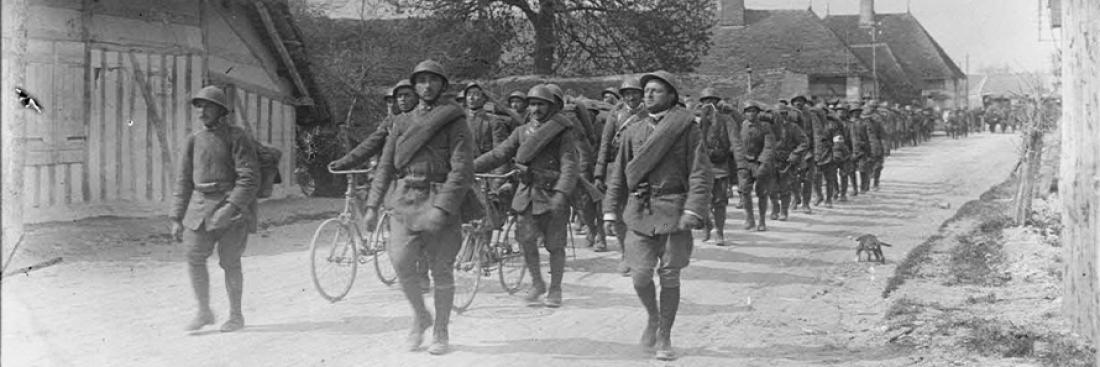Parmi ces victimes civiles, reposent notamment les dépouilles de femmes et d'enfants parfois en bas âge, comme Madeleine Beaujeux 4 ans (tombe n°157) ou Louise Questroy 12 ans (tombe n°89). Deux sœurs, natives d'Origny-en-Thiérache, Yvonne (24 ans) (tombe 79) et Noëlla (20 ans) (tombe 77) décédées respectivement le 25 mai et 7 juin 1917 y sont inhumés ainsi qu’un père et son fils, natifs de Colligies, Eugène Grenier 21 ans et Ernest Grenier 49 ans décédés respectivement les 12 et 17 octobre 1917 (tombes 162 et 163).
Raymond Senville (ou Senneville), jeune ouvrier belge de 19 ans mort en mars 1917 (tombe collective n° 9) et des prisonniers comme l'italien - Gustave Guillianet (tombe n° 44) et le russe, Nikita Gusno (inhumé dans l’ossuaire) ou selon l’état civil Mikolei Gusero décédé le 17 avril 1917 sont également enterrés sur ce site.
L’Aisne occupée
En septembre 1914, après la bataille de la Marne, les armées allemandes reculent jusqu’au plateau du Chemin des Dames, entre Laon et Soissons : la vallée de l’Aisne représente plus ou moins les limites de la ligne de front. Le nord du département est en contact direct avec le front de la Somme dès juillet 1916, puis celui du Chemin des Dames en avril 1917 et mai 1918. A l’arrière-front, la présence militaire ennemie est dense. Les civils vivent aux côtés de l'occupant et subissent les aléas de la situation militaire. Peu à peu, ils sont évacués vers l’arrière. L’occupation en France engendre des pénuries de main d'œuvre, de bétail et d'engrais. Aussi, les autorités allemandes veillent à exploiter les ressources dont elles disposent. Faute de volontaires, et après une émeute en raison de la pénurie de pain en mars 1916 à Lille, elles choisissent de réquisitionner la main d’œuvre urbaine. Ainsi, ils "déportent" environ 22 000 personnes de la région de Lille pour effectuer les travaux agricoles. Hommes et femmes sont alors envoyés dans les départements ruraux de l’Aisne ou des Ardennes. A l’automne, certains regagnent Lille. En octobre 1916, les Belges sont requis de manière autoritaire dans des bataillons de travailleurs – Zivilarbeiterbataillonen (ZAB) pour rejoindre l'Allemagne ou les territoires occupés de France où les conditions de vie sont très dures. Près de 120 000 Belges sont mis au travail forcé. Les hommes seuls sont d’abord employés par l’armée, puis, en 1917, la "levée générale" est décrétée pour toutes les femmes de 15 à 45 ans. Les malades des ZAB sont envoyés à l’hôpital de la VIIe armée allemande à Effry, dans l’Aisne, véritable mouroir.
Le lazarett d’Effry
Installé dans les locaux déserts de l’ancienne usine Briffault, près de l’Oise, le lazarett d'Effry est un immense hangar de 900 m² où s'entassent près de 1400 à 1600 personnes de nationalité française, belge, roumaine et russe. Dépourvus de soins, ces malades s’entassent, au cours du rigoureux hiver 1917, dans cet hôpital où les privations sont nombreuses. Dans le hangar, il n’y a pas d’aération. Vivant dans l'obscurité, les détenus français ou belges sont demi-vêtus. Les Roumains, les Russes, sont nus. Privés souvent de couvertures, les malades dorment à même le sol sur la paille infestée de vermine. La nourriture est rare. Les maigres provisions attribuées par l’armée au lazarett sont détournées par les officiers. Rapidement, des épidémies de diphtérie ou de dysenterie se propagent. La moyenne des décès est de 5 à 6 morts par jour, mais selon les périodes, il peut y avoir jusqu’à 20 à 30 décès par jour. Malheureusement, les conditions sont telles qu'il est difficile d'en connaître le chiffre précis.
Aujourd’hui, il subsiste de l’histoire de ces personnes, un cahier d’écoliers où sont retranscrits les noms de 710 personnes décédés dans cet "hôpital" à compter du 6 mars 1917, mais il y en avait avant cette date. Beaucoup n’ont pu être réellement identifiés et inhumés en tombe individuelle car les corps étaient entassés dans des fosses communes.
En janvier 1919, les habitants d’Effry saisissent le président de la République française pour qu’une enquête soit diligentée auprès de la Commission d’enquête sur les actes commis par l’ennemi en violation du droit des gens en vue de sanctionner le docteur Michelsohn, médecin chef du lazarett civil d’Effry.
Oscar Michelsohn, le docteur tortionnaire du lazarett d'Effry
Oscar Michelsohn suit l’itinéraire du lazarett local d’abord basé à Chauny, puis à Effry, et enfin à Trélon. Il recrute son personnel notamment le sous-officier Martin, qui détourne 600 kg de denrées en neuf mois. Il rafle, parmi les civils de Thiérache, des infirmières, des religieuses ainsi que le docteur Jules Pichard, médecin à Chauny qui se dévouent auprès des malades et partagent, parfois, le même destin que toutes les femmes du camp.
Considéré comme un monstre, le docteur Michelsohn se montre des plus violents à l'égard des malades privées de soins et de nourriture. Après la guerre, les villageois, groupés derrière Jules Pichard, cherchent à obtenir une condamnation judiciaire de Michelsohn. Le 28 juin 1922, Oscar Midelsohn est jugé à Leipzig mais il est acquitté.
La nécropole nationale d'Effry
En 1917, les morts d’Effry sont ensevelis dans des fosses communes qui sont ouvertes en 1927, date à laquelle le site est aménagé par le Ministère des Pensions. En 1993, sous l'impulsion d'élus locaux, le Ministère des Anciens combattants et victimes de guerre finance la réhabilitation de la nécropole. Le 14 mai 1994, sous le haut patronage de François Mitterrand, président de la République, l’ossuaire rénové est inauguré. Cette date devient alors le jour officiel de commémoration du calvaire des prisonniers d’Effry.
